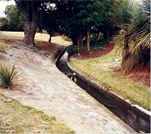PDF of this article (182 KB)


Does involving local people in reducing coastal hazards lead to better environmental outcomes? Terry Hume, Paula Blackett, and Jim Dahm surveyed seven community groups to find out.
Community groups are playing a growing role in coastal hazards mitigation as policy agencies increasingly focus on community participation, inclusion, and consultation, and put more emphasis on voluntary environmental actions. This community involvement is thought to have many benefits: it can improve the quality of decisions and overall environmental results, build community relationships, and increase local capacity to understand and manage environmental issues. At the same time, there has been a shift away from hard engineering and a ‘humans against nature’ approach, and increased emphasis on managing humans rather than nature.
Terms of reference
To find out how community groups are born and survive, and the factors that lead to positive environmental outcomes, we undertook a series of case studies. These were based on interviews with key players within seven communities, local authorities, and technical specialists. Our study investigated community groups initiated by local authorities for a specific function, as well as those formed independently for either a lobby or action-oriented reason.
For the purposes of our survey, ‘positive environmental outcomes’ are defined as those which meet the requirements of the Resource Management Act Section 6 – ‘retain natural character’ – because this phrase is echoed throughout planning documents nationwide. In this context, ‘soft’ options, like dune re-vegetation or managed retreat, are ‘positive environmental outcomes’ because they do not impact on natural character, are not contrary to many district plans, and do not reduce the amenity value of the area for the wider community. ‘Negative environmental outcomes’ may be options based around shoreline armouring (or some other hard engineering option), which may succeed in stopping the shoreline from retreating further but will generally lead to a loss of high-tide beach and of natural character of the area.
Keys to success
We found that positive or negative environmental outcomes depend on the relations between community groups, regulators (such as councils), and technical experts, and on the way those groups interact. These interactions are also shaped by external forces from the media and political pressures. Positive outcomes are encouraged when:
- Cooperative relationships are developed.
- Local authorities facilitate group learning.
- Communities have access to resources such as funding, technical knowledge, and assistance from inspirational leaders.
- The local authority takes time to build trust.
- Perceived – as well as actual – risks are addressed.
- Claims by lobby groups to represent the wider community are tested.
- Scientific information is introduced at the right time and in accessible language.
- Good records of the physical situation and of past attempts to resolve problems can help minimise the time spent revisiting the situation with new owners.
Dr Terry Hume is a coastal scientist and manager at NIWA, Dr Paula Blackett is a social scientist at AgResearch, and Jim Dahm is a coastal consultant. This work is part of GNS Science’s programme ‘Geological Hazards and Society’, funded by FRST. The authors are grateful to the individuals, community groups, and regional council officers who participated in the survey.
Teachers’ resource for NCEA Achievement Standards or Unit Standards: Geography Level 1 US5083, Level 2 US5089, Level 3 US5097, AS90703
